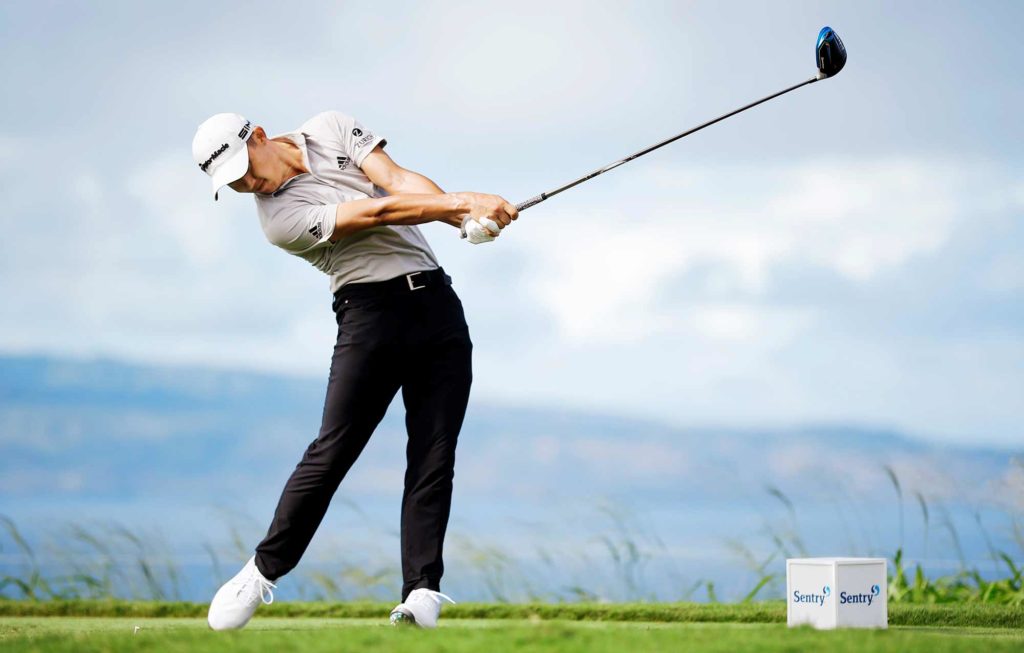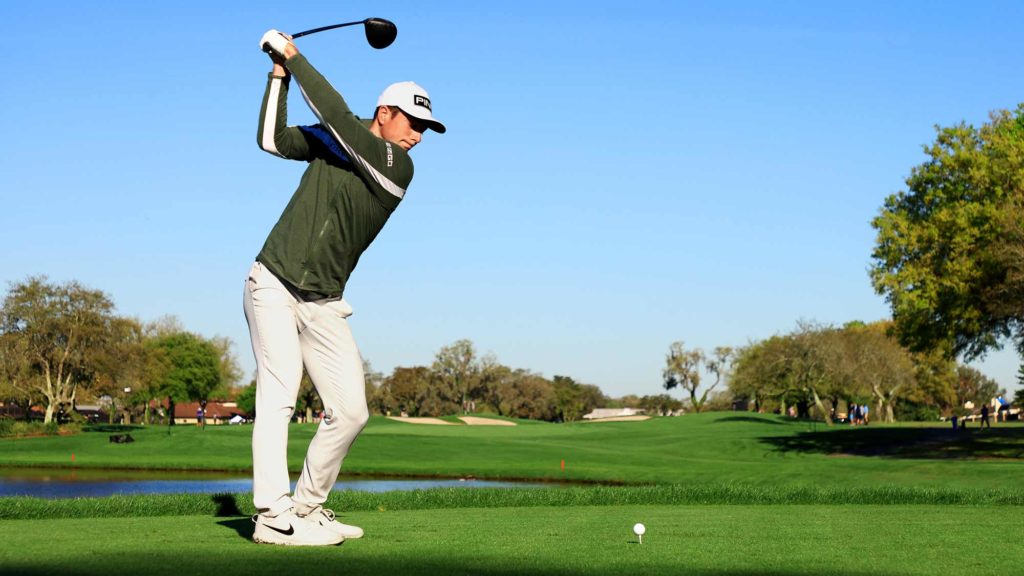*The right one could get you 17 more yards with the driver, but finding it is as much art as science.
The field at this year’s Puerto Rico Open had 132 exceptionally talented golfers with similarly perfect swings as hypnotic as the nearby palm trees blowing in the island breeze. But when you looked closer, a subtle but distinct difference kept reflecting in the light: bits of metallic blue in one moment, sparkly green or smoky black in another place, shiny silver here, and hints of red, yellow or even orange over there, each tracing that perfect line between hands and clubhead. Shoes, hats and even physiques have a certain consistency on the PGA Tour, but the driver shaft reveals a rainbow palette of variety, and not just in colours – 68 of the 132 players used a different driver shaft. On its face, that number sounds absurd. Tour-player swings all hover in the same swing-speed range. Why would there need to be so many models? How is such subtlety possible or necessary?
The reasons aren’t entirely clear, but finding a shaft that’s perfectly suited for your game isn’t only for golfers with their names on their bags. A Golf Digest/Club Champion test with a 10-handicapper revealed as much as a 17-yard difference between similar – but not the same – driver shafts. And even that gain isn’t as clearly defined as it might initially appear to be [see chart, below]. In a game increasingly adept at measuring potential performance, the mysterious, mystical shaft is the game’s last great frontier. But like all frontiers, it still lacks a map.
The voyage for a pro starts with a precise fitting, says Don Brown, vice-president of innovation and product creation for True Temper Sports, makers of the Project X brand of shafts, which includes the HZRDUS and EvenFlow lines. “Guys can use a launch monitor to dial in tenths of a degree of launch and spin by 50 revolutions per minute to get optimal launch conditions,” Brown says, “whereas 20 years ago, they mostly stood on the range with their caddies and said, ‘Yeah, that looks like the right window.’”
But when the same analytical tools that PGA Tour players rely on are found at nearly any golf shop, the shaft search becomes a shifting minefield of science joining forces with art. The game’s best clubfitters watch the readouts from high-tech launch monitors with nuclear physics-like precision while trying to translate all that maths into what the 12-handicapper in front of them is trying to communicate about “feel”.
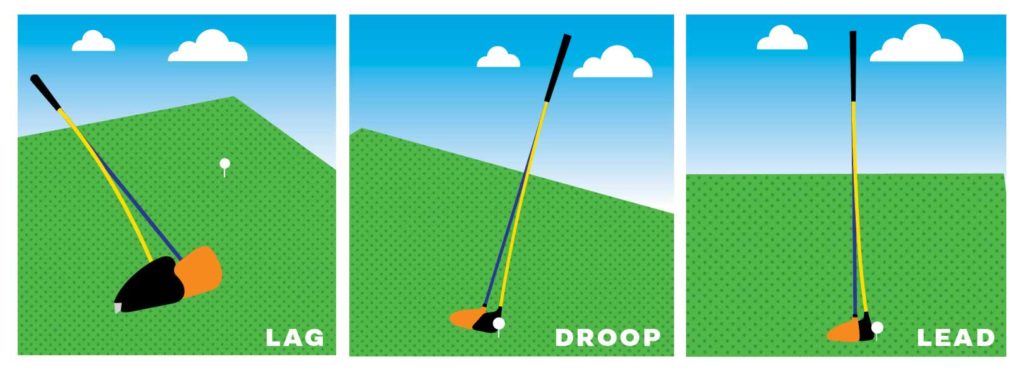
The various ways a shaft bends during the swing
▶ Golf biomechanist Sasho Mackenzie’s research with Ping reveals how a shaft bends during the swing and how that bending affects clubhead speed. In the illustration above, the yellow shaft represents the typical bending compared with the theoretical unbending blue shaft. During the downswing, the shaft bends back (called “lag”). Near impact, the shaft bends down (“droop”) and then towards the target (“lead”). Mackenzie’s research found that forward bend (called “kick velocity”) increased with more flexible shafts than with stiffer shafts but not for all players. And even though kick velocity might increase, the overall clubhead speed didn’t change because that forward-bending effect causes the hands to slow down. Says Mackenzie, “There’s not really a great way to be able to predict who is going to get that clubhead speed.”
One who has studied that variety is Jon Sinclair, one of the top-rated teachers in Texas and a clubfitter and consultant to shaft manufacturer TPT. Sinclair has captured 3D data on thousands of swings, perhaps more than anyone, and he has seen just three or four things that rise to the level of similar fundamentals in all those moves. “When I look at all the 3D swings in my database, it is enough to tell you that a golf swing is a fingerprint,” he says. “Having all these shaft options shouldn’t be a surprise; it should be encouraging.”
The implication of these swing varieties and shaft options is clear: the vast majority of recreational golfers are playing the wrong driver shaft. Whether they have the capacity to realise this and the time, interest and money to discover the truth is a more difficult question. Nick Sherburne, founder of leading clubfitting-franchise Club Champion, believes 90 percent of average golfers use a shaft that is not optimal for their potential.
“They just have a run-of-the-mill golf shaft,” he says, admitting, of course, that part of his business is getting golfers into the right and often more expensive shaft. “It’s not that what they have is crap; it’s that it’s not specific. The shaft is the missing link to the best possible performance. Get the right shaft and your swing becomes more effortless. Let the head solve direction. The right shaft is going to be all about consistency and speed, speed, and more speed.”
The challenge is that there are thousands of potential right shafts. Companies like Fujikura, Mitsubishi and True Temper each offer hundreds of driver-shaft options, sometimes dozens under the same model. Fujikura’s Ventus, which has been the most played shaft on the PGA Tour, is available in 23 versions on its website. True Temper’s Project X HZRDUS has 70 varieties. Mitsubishi’s tour-proven Tensei family of driver shafts has 111 options. Each of those companies, and more than a dozen others of substance, are cooking up more each day. Although there is considerable overlap among models, weights and flex profiles, the differences remain hidden in pockets of knowledge among fitters and engineers. Mix in driver heads that adjust and the fact that individual shafts can be cut from the tip end to alter stiffness, and it seems paralysing for the lonely golf consumer to even start on the journey to finding the right one.
To their credit, shaft companies and a fair number of club manufacturers offer interactive online tools and guides that allow golfers to match swing characteristics and trajectory desires to narrow that universe of shafts. GolfShaftReviews.info, the website that is to golf-shaft gearheads what the Sibley Guide to Birds is to aspiring ornithologists, has profiled the technical details of more than 2,000 driver shafts. TrueFitClubs.com measures shafts across 21 metrics to match your golfer profile to get specific online recommendations. Mizuno’s Shaft Optimiser, first developed for iron shafts and now used for drivers, has sophisticated strain gauges, hardware and software to demonstrate how your swing makes a shaft bend. Then Mizuno correlates those forces to shaft profiles that will fit your game best. Even artificial intelligence has come to shaft matching. SwingFit uses motion-capture analysis to track more than 30,000 data points per swing to determine the ideal club and shaft combination.
But no matter how detailed the analysis, the right shaft usually comes down to the hitting – and all the quirks that implies. Feel to a golfer, even an average Joe, can’t be reduced to an eHarmony.com algorithm. (Relationships between humans involve compromise; the right shaft matched to the right golfer, on the other hand, is the perfect bliss of the gods.)
“When you’ve got a flexible stick in your hands and what is basically a hammerhead, and then you have 20 million individuals delivering this hammerhead in 20 million different ways, well, that’s a mystery that might never get solved,” says John Oldenburg, who has been designing shafts you’ve likely played for nearly three decades and now is director of shaft development for Ping. “No doubt you can change the performance of the golf club with the shaft.”
That isn’t just the opinion of shaft makers and clubfitters and others trying to sell you the latest miracle in a stick made of carbon fibre, resin and paint. It’s science. One doctoral thesis on the subject cites 37 pages worth of past research. Summing up that analysis on the golfer-shaft symbiosis neatly is Sasho MacKenzie, a professor of human kinetics at Canada’s St Francis Xavier University, who has been studying shafts for nearly two decades. MacKenzie, who has a PhD in sport biomechanics and did his doctoral thesis on shaft stiffness and golfer performance, has recently written in published research that “robotic testing reveals relatively clear relationships between each shaft property and clubhead delivery”. But, he also writes, “when the neurobiological nuances of a human golfer are called upon to supply the kinetics to the grip of the club, those clear relationships become considerably stirred”.
Talk to him outside a science journal, though, and he’s a golfer like the rest of us. He concedes getting a player’s swing and shaft together requires more than stirring. “It seems really hard to predict,” he says. “But I would say ‘chaotic’ is a good word because it is deterministic. There is cause and effect.
“There is this mystique about what the shaft does. Each golfer loads it so differently. I sunk a reasonable amount of time in trying to sort it out, and I came to the conclusion that whatever method we come up with – let’s say it has something to do with grip strength, flexibility, downswing time, stance width, whatever it is – my gut would still be to give me a launch monitor and a bunch of balls, and let’s see how the shaft changes the results.”
▶ same speed, different ways The clubhead speeds of Collin Morikawa [above left] and Viktor Hovland [above right] are nearly the same, but their different movements during the swing lead them to use different shaft models. Factors include how aggressive the player transitions in a few milliseconds of the downswing and how firm or soft various sections of the shaft feel.
That is not a terrible compromise. Good fitters know shafts not so much by “R”, “S” and “X” but by the way shaft engineers talk about bend profiles, particularly what’s called the EI curve. Generally the shape of an upwardly sloping stock trendline, the EI curve reflects a series of calculations of a force applied at multiple sections of the shaft. It shows the relative stiffness of the butt section compared to the middle and the tip and is a means of comparing those sections to other shafts that might be labelled with the same overall stiffness. There are clearly similar types of shafts, or what Russ Ryden, the top fitter behind the Golf Shaft Reviews website and a designer of EI curve measuring machines, calls “archetypes”. He suggests one of the more popular profiles is shafts that are softer in the middle section. Another has a decrease in stiffness from butt to tip, and a third might trace that decreasing stiffness slope more steeply, especially to the extreme at the tip.
“Successful technologies survive,” he says. “That soft mid design is really the best fit for the majority of golfers. Is the soft mid a shock absorber for inconsistent or jerky loading on the downswing? That might be why it’s made by every company in all kinds of variations and price points.”
This idea of loading or applying force at various points during the swing is meant to correlate with how the shaft bends in multiple directions and depending on a golfer’s swing, speed and strength. Stories from fitters of golfers with poorly fitting shafts having to compromise their driver swings or work too hard to achieve optimal conditions are common.
“I had a young golfer come in who was swinging his 6-iron at 93 miles per hour, but he was barely swinging his driver any faster,” says Mark Timms, longtime fitter and chief executive of high-tech fitting chain Cool Clubs. “When I measured his driver shaft, it was near what would be called a soft flex despite what it said on the label. He had slowed his driver swing just to keep the ball in play. You wonder if he’ll ever get that speed back. The right shaft, even for a high-handicapper, lines up with the signature of your swing.”
There are general rules all fitters use: (1) A lighter shaft will be easier to swing faster and is likely to launch the ball higher. But it’s best to match your strength to shaft weight. (2) A more flexible tip section compared to the butt section likely will launch the ball higher. Conversely, shafts that are heavier and have less flexible tip sections than the butt section will launch the ball lower and are best for fast swingers. But even with all his shaft measuring and analysis, Ryden isn’t a fan of predictions.
“Giving fitting advice without seeing the swing and testing different combinations is a swamp,” he says, noting that if you are looking for a shaft that’s going to address your giant slice or significantly alter your launch angle, guess again. Lessons with a quality teacher should be your first stop and maybe the clubhead can help a little more. The shaft is there to bring out your best, not eradicate your worst.
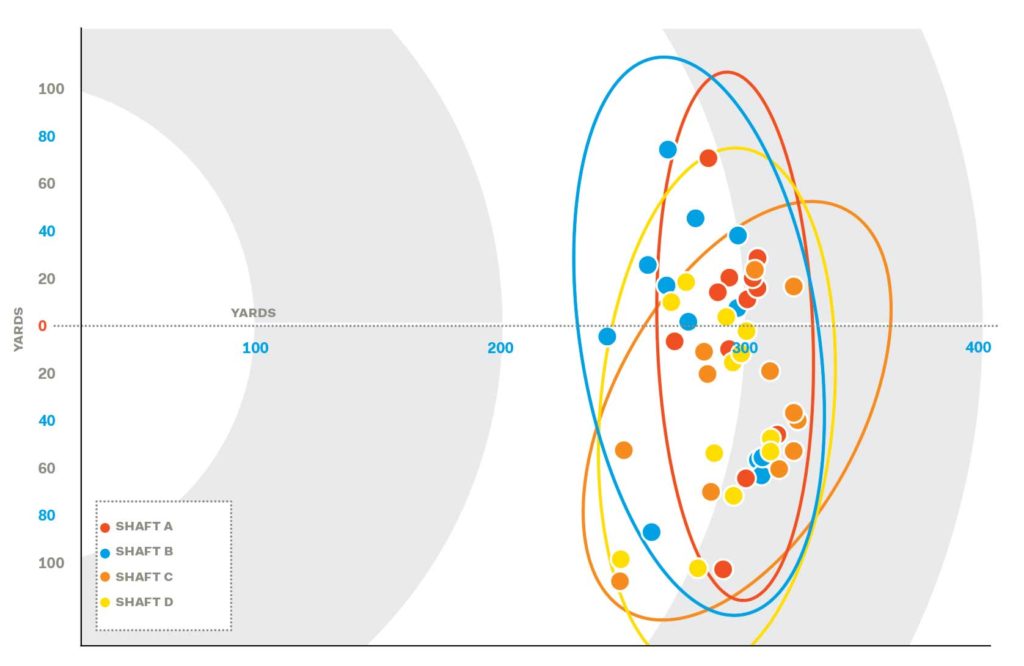
Test: a 10-handicapper, four stiff shafts and a 17-yard difference
▶ In our test with leading clubfitter Club Champion, we had a 10-handicapper with a higher than normal swing speed hit 10 to 12 shots each with four shaft models from the same company, cycling through the shafts every three swings. All were labeled “stiff”, but each had a slightly different profile, or what’s called an “EI curve” that measures the relative stiffness of different sections along the shaft. In other words, all of these stiff shafts were the right starting point, but in theory they were different enough that one might produce better results based on the way our player swings the driver. Although not instantly clear from the distance and dispersion circles seen here, the data showed that shaft C and shaft A produced the best average distances (with shaft C a little longer and and shaft A a little straighter) by about 17 yards (or 15.5 metres) over shaft B and about seven yards (6.4 metres) over shaft D. The differences were even more dramatic than expected for Club Champion founder Nick Sherburne. He saw swing-speed improve by three miles per hour from the worst to the best shaft, for example. “The shaft was clearly making him release at different times, and this was with shafts with only minute differences,” he says. “It’s what we see every day and why you should get fit.” Still, there’s uncertainty. Factoring in the standard deviation showed less clarity among the four shafts. And there’s this: our player, without knowing the results, did prefer one of the two shafts with better numbers but wasn’t completely satisfied with the feel of any of them.
Martin Broulliette, a professor of mechanical engineering at the University of Sherbrooke, a member of the Golf Digest technical panel and someone who has been fitting golfers for 20 years, urges a simple approach. He believes there is an ideal shaft weight for each golfer that will produce more clubhead speed, and that a launch monitor will be clear about which shaft produces the best launch conditions. But don’t focus only on distance, he says: “Play the stiffest shaft that you can tolerate, to minimise shot dispersion,” he says, emphasising tolerate.
Because carbon fibre keeps improving, though, the possibilities keep multiplying. For instance, tour-level golfers now swing lighter shafts that maintain their stiffness at swing speeds of 120 miles per hour or more. Some estimate that shafts on tour today can maintain gram weights in the 60s but are twice as stiff as they were a decade ago. For paying customers, technology and material gains mean some graphite shafts weigh half what they once did.
“Shaft designs from 10 years ago couldn’t be more different than they are today,” says Alex Dee, Fujikura’s veteran designer and vice-president. “Our current designs have more than double the number of plies per part compared to shafts made back then. By using thinner materials with more carbon content and less resin, we’ve been able to better fine-tune the structure, enhancing feel and performance and improving strength and endurance. We’ve been able to design completely different products with performance metrics previously impossible unless weight was sacrificed.”
The vast majority of golfers, of course, don’t opt for one of these aftermarket custom shafts, sticking with the stock version that comes with the driver they buy. Stock shafts are really designed to not offend or alienate any potential customer, but they are not optimised for individuals. Just as you can buy pants with a 34-inch waist, they won’t feel ideal if your waist is 33¼. Can you wear the 34s and make it through your day without them falling off? Of course.
But how much better would your day be with perfectly fitting pants?
It’s easy to know our waist size, but defining swing types that match shaft profiles might require a ruler that has not been invented yet. Timms has been studying this golf-component unicorn matrix with next-generation measuring devices for decades, and he is still trying to crack a code he believes exists.
“All of shaft fitting now is essentially trial and error,” he says. “The ideal amount of shaft bend and where along the shaft it bends can differ from golfer to golfer. But we haven’t figured out why yet. Right now, we’re just handing it to them, and if it works, it’s right.”
Shaft companies understand that subtlety and continue to explore the idea that the differences are knowable and meaningful. Fujikura’s ENSO camera system analyses swings and their effect on the shaft at 2,000 frames per second. Mitsubishi is pulling from carbon-fibre varieties originally developed by its parent company to lighten aeroplanes or strengthen buildings and bridges from earthquakes.
“In the past the shaft might have been pretty close for a player, but then we would adjust the head to match. Now the shaft is becoming that non-variable, that constant that you can pair with the right head combination,” says Zane Nuttall, manager of product development and innovation for Mitsubishi. “We’re eliminating more variables by providing more options.”
That’s what tour players do on a weekly basis: confirm that the connection between hands and driver head is still seamless. That decision might have taken days or weeks of testing in the past, but now through adjustable hosels and launch monitors, it might take only a couple of swings. When he thinks about how he combines his teaching with his clubfitting, Sinclair says average golfers should approach their shaft search the same as the best golfers. “If an elite player can’t just play anything,” he says, “neither should anyone.”
The shaft industry has become much smarter at understanding how a shaft’s properties effectively align with certain swing types. It’s not unlike doctors staring at the array of medical options as they desperately search for the right way to fight a disease. It’s not that the wrong choice won’t work; it might make the disease worse. In golf terms, the shaft choice is critical, too. In both cases, the only real mistake is doing nothing.
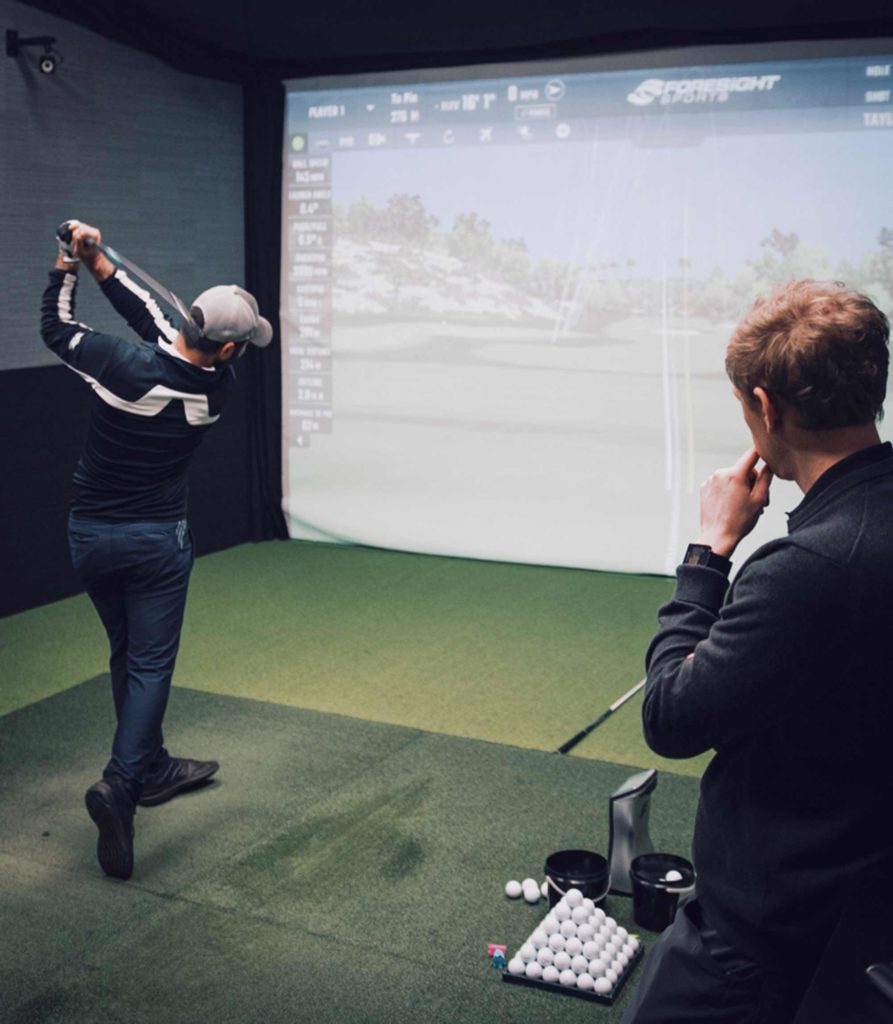
Where to go to get fitted
▶ Our list of 50 Great Clubfitters considers all sorts of facilities that offer clubfitting access to the general public and is the result of detailed polling of our Top 100 Courses panellists and industry sources (including equipment manufacturers). Those include independent shops, practice ranges and full-service performance centres, large retail stores, resorts, golf courses and national chains. With literally hundreds of great options out there, this isn’t a ranking. It’s a small sample of professional fitters who all boast the leading resources, tools, expertise and fitting methodology to help you play your best golf. A quick Google search can help you locate your nearest clubfitter but starting with your club’s PGA-accredited professional is a good option. Remember: the right-fitting clubs don’t always require a purchase, but they do require someone dedicated to your best interests. The best place to find that? Go to pga.org.au/find-a-pga-pro

Drummond Golf has experienced clubfitters in its stores across the country.
New South Wales
JASON LAWS
Jason Laws Academy, Fern Bay NSW
(02) 4928 1664
GLENN WHITTLE
Tempe Driving Range, Tempe NSW
(02) 9559 1162
PAUL JENNER
PureForm Golf, Alexandria NSW
(02) 9669 3200
STEVE AISBETT
Thornleigh Golf Centre, Thornleigh NSW
(02) 9875 5445
MATTHEW ALLAN
Coffs City Golf Centre, Coffs Harbour NSW
(02) 6652 3266
NICK ODZE
Power Golf,
Castle Hill NSW
(02) 9634 1477
LEE HUNT
Bankstown Golf Club, Milperra NSW
(02) 9773 0628
RAY HAWKINS
Precision Golf, Chatswood NSW
(02) 9417 7704
DAN GOODES
The Ridge Golf Complex, Barden Ridge NSW
(02) 9541 4960
JOHN COOTE
Inverell Golf Club, Inverell NSW
(02) 6722 1574
ROBBY STEPHENSON
Links Shell Cove,
Shell Cove NSW
(02) 4237 5955
WILL URASAKI
TaylorMade Golf
0434 926 778
PAUL DAVIS
Beverley Park Golf Club, Beverley Park NSW
(02) 9588 5828
Australian Capital Territory
MIKE SERES
Drummond Golf, Fyshwick ACT
(02) 6232 6611
CRAIG SMITH
Gold Creek Country Club, Nicholls ACT
0451 050 945
Victoria
NICHOLAS WARD
Golf Studio, Mordialloc
0448 100 784
MATT TUDOR
Golf Fitting Hub, Melbourne
(03) 9510 5588
MATT BOLTON
Bolton Performance Golf, Rosebud VIC
(03) 5950 0888
JENNA HUNTER
Mt Derrimut Golf & Community Club, Derrimut VIC
0433 761 298
ANGELA TATT
Ballarat Golf Club, Alfredton VIC
0402 503 579
MARK WONG
Callaway Golf South Pacific, Rowville VIC
(03) 9212 9400
JAMES McCULLY
Black Bull Golf Course, Yarrawonga VIC
(03) 5744 0044
CAMERON HOWELL
Horsham Golf Club, Horsham VIC
(03) 5382 1652
RICHARD QUESTED
The National Long Island Golf Club, Frankston VIC
(03) 9707 9900
MARK VARELLA
Green Acre Golf Club, Kew East VIC
(03) 9859 1294
ALEX BENJAMIN
TaylorMade Golf Australia (VIC)
(03) 9263 5283
DANIEL POPOVIC
Mizuno Corporation Australia, Mulgrave VIC
(03) 9239 7100
Tasmania
MATT DOCKING
Royal Hobart Golf Club, Hobart, TAS
(03) 6248 6161
AIDEN WITHERS
Seabrook Golf Club
(03) 6442 2173
JASON RUSSELL
Drummond Golf, Launceston TAS
(03) 6334 1919
South Australia
WARREN MERCER
The Grange Golf Club, Grange SA
(08) 8356 3070
CHRISTINE BURTON
North Haven Golf Course, North Haven SA
(08) 8248 3832
SHANE ROBINSON
Glenelg Golf Club, Novar Gardens SA
(08) 8350 3200
MATT DENT
Blackwood Golf Club, Cherry Gardens SA
(08) 8388 2250
Western Australia
ROB FARLEY
Marangaroo Golf Course,
Marangaroo WA
(08) 9247 1733
TROY MURPHY
Capel Golf Club, Stratham WA
0400 761 028
MATT ELLIOTT
Wembley Golf Complex, Wembley Downs WA
1300 818 574
VERNON SEXTON-FINCK
Joondalup Resort, Connolly WA
(08) 9332 7497
BRAD LOGAN
Royal Perth Golf Club, South Perth WA
(08) 6436 4900
TRISTAN McCALLUM
Seaview Golf Course, Cottesloe WA
(08) 9384 8879
ELLIOTT TAYLOR
GolfBox, Booragoon WA
(08) 9468 3275
Queensland
ADAM CLARKE
Cobra-Puma Golf (QLD)
0413 263 156
MICK MURNAME
Bundaberg Golf Club, Bundaberg North QLD
(07) 4151 6706
SHANE REVELL
The House of Golf, Bundall, QLD
(07) 5538 2699
CHRIS RUTHERFORD
Victoria Park Golf Complex, Herston QLD
(07) 3252 0666
SHANE HEALEY
Noosa Golf Club, Tewantin QLD
(07) 5447 1407
ATOMU WATANABE
Atomu Golf,
Warana QLD
0400 666 527
SEAN SEYMOUR
Maroochy River Golf Club, Bli Bli QLD
(07) 5457 0900
MAX HORLIN
TaylorMade Golf Australia (QLD)
0412 366 080
Northern Territory
STEPHEN TIECK
Alice Springs Golf Club, Desert Springs NT
(08) 8952 1921

